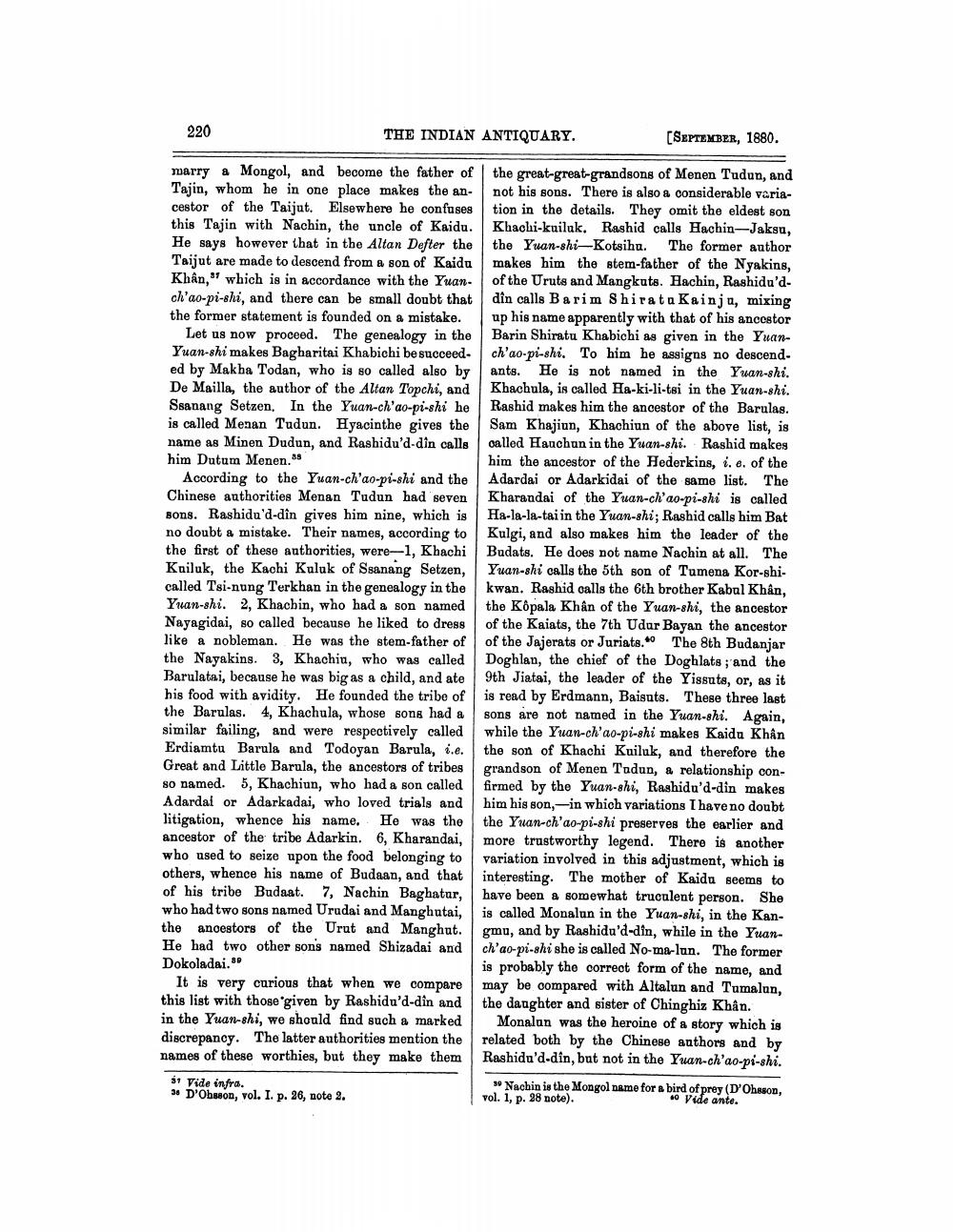________________
220
[SEPTEMBER, 1880.
the great-great-grandsons of Menen Tudun, and not his sons. There is also a considerable variation in the details. They omit the eldest son Khachi-kuiluk. Rashid calls Hachin-Jaksu, the Yuan-shi-Kotsihu. The former author makes him the stem-father of the Nyakins, of the Uruts and Mangkuts. Hachin, Rashidu'ddin calls Barim Shirata Kainju, mixing up his name apparently with that of his ancestor Barin Shiratu Khabichi as given in the Yuanch'ao-pi-shi. To him he assigns no descendants. He is not named in the Yuan-shi. Khachula, is called Ha-ki-li-tsi in the Yuan-shi. Rashid makes him the ancestor of the Barulas. Sam Khajiun, Khachiun of the above list, is called Hauchun in the Yuan-shi. Rashid makes him the ancestor of the Hederkins, i. e. of the Adardai or Adarkidai of the same list. The Kharandai of the Yuan-ch'ao-pi-shi is called Ha-la-la-tai in the Yuan-shi; Rashid calls him Bat Kulgi, and also makes him the leader of the Budats. He does not name Nachin at all. The Yuan-shi calls the 5th son of Tumena Kor-shikwan. Rashid calls the 6th brother Kabul Khân, the Kôpala Khân of the Yuan-shi, the ancestor of the Kaiats, the 7th Udur Bayan the ancestor of the Jajerats or Juriats. The 8th Budanjar Doghlan, the chief of the Doghlats; and the 9th Jiatai, the leader of the Yissuts, or, as it is read by Erdmann, Baisuts. These three last sons are not named in the Yuan-shi. Again, while the Yuan-ch'ao-pi-shi makes Kaidu Khân
According to the Yuan-ch'ao-pi-shi and the Chinese authorities Menan Tudun had seven sons. Rashidu'd-dîn gives him nine, which is no doubt a mistake. Their names, according to the first of these authorities, were-1, Khachi Kailuk, the Kachi Kuluk of Ssanang Setzen, called Tsi-nung Terkhan in the genealogy in the Yuan-shi. 2, Khachin, who had a son named Nayagidai, so called because he liked to dress like a nobleman. He was the stem-father of the Nayakins. 3, Khachiu, who was called Barulatai, because he was big as a child, and ate his food with avidity. He founded the tribe of the Barulas. 4, Khachula, whose sons had a similar failing, and were respectively called Erdiamtu Barula and Todoyan Barula, i.e. the son of Khachi Kuiluk, and therefore the Great and Little Barula, the ancestors of tribes so named. 5, Khachiun, who had a son called Adardai or Adarkadai, who loved trials and litigation, whence his name. He was the ancestor of the tribe Adarkin. 6, Kharandai, who used to seize upon the food belonging to others, whence his name of Budaan, and that of his tribe Budaat. 7, Nachin Baghatur, who had two sons named Urudai and Manghutai, the ancestors of the Urut and Manghut. He had two other sons named Shizadai and Dokoladai.
grandson of Menen Tadun, a relationship confirmed by the Yuan-shi, Rashidu'd-din makes him his son,-in which variations I have no doubt the Yuan-ch'ao-pi-shi preserves the earlier and more trustworthy legend. There is another variation involved in this adjustment, which is interesting. The mother of Kaidu seems to have been a somewhat truculent person. She is called Monalun in the Yuan-shi, in the Kangmu, and by Rashidu'd-din, while in the Yuanch'ao-pi-shi she is called No-ma-lun. The former is probably the correct form of the name, and may be compared with Altalun and Tumalun, the daughter and sister of Chinghiz Khân.
THE INDIAN ANTIQUARY.
marry a Mongol, and become the father of Tajin, whom he in one place makes the ancestor of the Taijut. Elsewhere he confuses this Tajin with Nachin, the uncle of Kaidu. He says however that in the Altan Defter the Taijut are made to descend from a son of Kaidu Khân," which is in accordance with the Yuanch'ao-pi-shi, and there can be small doubt that the former statement is founded on a mistake.
Let us now proceed. The genealogy in the Yuan-shi makes Bagharitai Khabichi be succeeded by Makha Todan, who is so called also by De Mailla, the author of the Altan Topchi, and Ssanang Setzen. In the Yuan-ch'ao-pi-shi he is called Menan Tudun. Hyacinthe gives the name as Minen Dudun, and Rashidu'd-din calls him Dutum Menen.
38
It is very curious that when we compare this list with those given by Rashidu'd-din and in the Yuan-shi, we should find such a marked discrepancy. The latter authorities mention the names of these worthies, but they make them
51 Vide infra.
38 D'Obsson, vol. I. p. 26, note 2.
Monalun was the heroine of a story which is related both by the Chinese authors and by Rashidu'd-dîn, but not in the Yuan-ch'ao-pi-shi.
Nachin is the Mongol name for a bird of prey (D'Ohsson, vol. 1, p. 28 note). 40 Vide ante.




